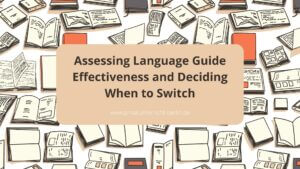Your Language Journey, Your Way: Start with a Private Tutor

Tackling Common Hurdles In Individual Language Instruction
Individual instruction can be the key to unlocking fluency and mastery for many language learners. However, this approach is not without its challenges. As a language instruction expert, I have seen firsthand how common hurdles impede progress and discourage even the most dedicated students.
Fortunately, with some understanding of these obstacles and strategies for overcoming them, individual language instruction can be an incredibly effective way to learn a new language.
In this article, we will explore some of the most frequent barriers that arise in one-on-one language learning sessions and provide practical advice on tackling them head-on. Whether you are a student looking to improve your skills or a teacher seeking ways to support your learners’ needs better, this guide will help you confidently navigate the world of individual language instruction.
Table of Contents
Overcoming Pronunciation Challenges
As an individual language instructor, one of the most common challenges students face is mastering pronunciation. It can be a source of frustration and embarrassment when you need to communicate effectively due to mispronunciation or accent. However, with the proper techniques, anyone can overcome these hurdles and achieve clear and confident speech.
Accent reduction techniques have proven effective in helping learners improve their pronunciation skills. These techniques involve identifying common pronunciation mistakes and working on them systematically through tongue twisters, listening exercises, and repetition drills. Learners can gradually develop more accurate pronunciation habits by focusing on specific sounds and patterns that pose difficulties for non-native speakers.
The following section will explore how addressing grammar and syntax struggles can further enhance communication abilities.
Addressing Grammar And Syntax Struggles
As language learners, we all know how frustrating it can be to struggle with grammar and syntax. These concepts are essential for clear communication in any language, but they can also be complicated to master on your own.
Fortunately, there are several effective strategies that you can use to address these common hurdles.
One of the most practical approaches is incorporating interactive exercises into your language learning routine. This could include completing sentence structures or creating dialogues using specific grammatical rules.
By actively engaging with the language, you’ll improve your understanding of grammar and syntax and develop a deeper connection to the language. Personalized feedback sessions with an instructor or tutor can help identify areas where you may need further clarification or practice. With their guidance and support, you can work through challenging concepts more quickly and gain confidence in your abilities as a language learner.
To maintain progress and motivation throughout your language learning journey, it’s essential to keep yourself engaged and excited about the process. To achieve this goal, consider setting short-term goals that align with your long-term objectives.
For example, challenge yourself to learn ten new vocabulary words each week or complete several grammar exercises daily. Consider incorporating different media types into your routine, such as movies or music in the target language.
Finally, don’t forget to celebrate small successes along the way! Acknowledging even minor accomplishments will help keep you motivated and energized as you continue working towards fluency.
Keeping Motivation High
As we addressed in the previous section, grammar, and syntax struggles can be major roadblocks in language instruction. However, addressing these issues is only one part of achieving fluency. To truly succeed, learners must also find ways to keep their motivation high throughout the learning process.
Symbolically speaking, maintaining motivation while learning a new language is like keeping a fire burning. The initial spark may come from excitement or curiosity, but it will quickly burn out without constant fuel and attention. That’s why instructors must help students set goals and incorporate cultural immersion into their studies.
To start with setting goals, here are some tips that instructors can share with their learners:
- Focus on specific outcomes: Rather than just saying, ‘I want to speak Spanish,’ try setting concrete goals such as ‘I want to be able to hold a conversation about my hobbies’ or ‘I want to understand news broadcasts.’
- Make them achievable: Goals should challenge learners without overwhelming them. Break significant objectives down into smaller steps that feel attainable.
- Celebrate progress: Recognizing even small milestones can help motivate learners to keep going.
In addition to goal-setting, incorporating cultural immersion experiences can provide an ongoing source of inspiration for language learners. Here are three ideas for how students can do this:
- Watch TV shows or movies in the target language
- Attend local events where they’ll hear the language spoken
- Connect with native speakers online through social media or language exchange apps
By staying motivated and engaged throughout the learning journey, individuals can overcome common hurdles and achieve true fluency in any language they choose.
Next, explore finding the right learning style for your unique needs.
Finding The Right Learning Style
One of the significant hurdles in individual language instruction is finding the right learning style. Every learner has a unique way of acquiring knowledge and skills, so it’s essential to identify which approach works best for them.
As a language instructor, I always begin by assessing my student’s strengths and weaknesses through various methods, such as interactive exercises or quizzes. This helps me understand what areas they need to focus on and how much time they’ll devote to each one.
Once I’ve identified their learning style, I can create a customized curriculum that caters to their needs. For example, if a student is more visual than auditory, I might incorporate more videos or images into our lessons. If they’re more kinesthetic learners who learn best through physical activities, we could practice conversational skills while playing games or doing role-play exercises.
By tailoring my teaching method according to their preferences, students can pick up new concepts quicker and retain information better. This increases their motivation and builds confidence in their ability to speak the language fluently.
Moving forward from identifying your preferred learning style and developing a customized curriculum is building practical communication skills. One strategy you can use is…
Building Effective Communication Skills
Imagine being able to communicate with anyone, anywhere, effortlessly. To express yourself in a foreign language with confidence and ease is a liberating feeling that opens up opportunities like never before.
However, building practical communication skills takes time and effort. It requires more than memorizing vocabulary lists or learning grammar rules; it demands practice and patience.
One way to improve your communication skills is through role-playing exercises. This technique allows you to simulate real-life situations where you can engage in conversation using the language you are learning. By stepping into different roles, such as ordering food at a restaurant or negotiating a business deal, you can practice various scenarios that will help you develop fluency and overcome any inhibitions about speaking in public.
To further enhance your ability to start conversations, consider using conversation starters. These prompts range from simple questions about someone’s day or interests to more complex topics related to current events or cultural traditions. They are an excellent tool for initiating dialogue and creating meaningful connections with native speakers of the language you are learning.
With consistent use of these techniques, determination, and perseverance, you’ll soon find yourself communicating effectively in any situation – whether it be a casual small talk or professional discourse – leaving you and your conversational partner feeling confident and fulfilled without even realizing how much progress has been made!
Frequently Asked Questions
How Do I Deal With Cultural Differences That Affect My Language Learning Experience?
Cultural immersion can be exciting and overwhelming when learning a new language. It is essential to understand that culture plays a significant role in language learning as it affects how people communicate and interact.
To deal with cultural differences, cross-cultural communication strategies are essential. These include active listening, asking questions for clarification, being open-minded and respectful towards different cultures, and adapting to nonverbal cues such as gestures or facial expressions.
Additionally, immersing oneself in the target culture through activities such as watching movies or TV shows in the target language or traveling to countries where the language is spoken can greatly enhance language learning experiences.
As a language instruction expert, I suggest incorporating these strategies into your daily routine so that you may develop positive relationships with individuals from different backgrounds while improving your proficiency in the target language.
What Are Some Effective Strategies For Expanding My Vocabulary Beyond Basic Phrases?
You can use a few practical strategies to expand your vocabulary beyond basic phrases.
One strategy is word association: whenever you learn a new word, try associating it with terms or concepts you already know. This will help you remember the comment and its meaning more quickly.
Another great strategy is immersive reading, which involves reading texts in your target language as much as possible. This will expose you to a wide range of vocabulary and grammar structures in context, helping you understand how words are used in real-life situations.
By using these techniques consistently and regularly, you’ll be well on your way to building a solid vocabulary foundation in your chosen language!
How Can I Overcome Anxiety Or Shyness When Speaking In My Target Language?
Overcoming anxiety or shyness when speaking in a target language requires practical strategies that can help boost your confidence.
As a language instruction expert, I recommend starting with role-playing exercises to simulate real-life situations and practice conversations in a safe environment.
Mindfulness practices are also helpful for reducing stress and increasing focus during language learning sessions.
Additionally, pronunciation drills can improve your speaking skills while engaging in language exchange programs allows you to interact with native speakers of the target language regularly.
By incorporating these techniques into your language learning routine, you will gradually build the necessary skills and confidence to speak fluently without hesitation.
Are There Any Specific Resources Or Tools That Can Aid In My Individual Language Instruction?
To enhance your language instruction, you can explore the vast array of online digital resources and interactive activities. These tools provide a dynamic way to practice new vocabulary, grammar rules, and pronunciation in a fun and engaging manner.
Some examples include language learning apps like Duolingo, Babbel, or Rosetta Stone that offer personalized lessons tailored to your needs.
Interactive websites like Quizlet provide flashcards, quizzes, and games to help learners memorize critical phrases and concepts.
Additionally, YouTube channels featuring native speakers or teachers conducting conversations can be an excellent resource for improving listening comprehension skills.
With these resources at your disposal, you’ll find it easier to tackle any hurdle on your journey toward fluency!
How Do I Balance My Language Learning Goals With Other Responsibilities And Commitments In My Life?
While learning a new language can be an exciting and rewarding experience, it’s essential to balance your language goals with other commitments in your life.
Time management is crucial for individual language instruction – setting aside dedicated study time each day or week will help you stay on track and progress toward your goals.
Additionally, motivational techniques such as finding a language exchange partner or keeping a journal in the target language can help keep you engaged and motivated throughout the learning process.
As a language instruction expert, prioritize consistency and self-discipline to achieve success in your language learning journey.
Conclusion
In conclusion, conquering a new language can be both challenging and rewarding. As an individual language learner, you may encounter cultural differences that affect your learning experience. However, with the right mindset and willingness to embrace these differences, you can expand your understanding of the language and culture.
Expanding vocabulary beyond basic phrases requires dedication and effective strategies such as reading books or articles in your target language or actively seeking out opportunities for conversation practice. Overcoming anxiety or shyness when speaking in your target language may take time and effort, but it is possible through consistent practice and building confidence gradually.
As an expert in language instruction, I encourage you to utilize specific resources such as online dictionaries or flashcard apps to aid your language learning journey.
Lastly, balancing language learning goals with other responsibilities may seem daunting, but setting achievable milestones and prioritizing daily study sessions will help you reach fluency faster. Remember: Rome wasn’t built in a day! Patience and persistence are essential idioms that will guide you toward success in mastering a new language.



